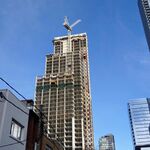A
AlvinofDiaspar
Guest
From Reading Toronto:
2007 03 15
Greening Toronto’s Concrete Slab Towers
By Graeme Stewart
There has been much talk in recent months of Toronto’s strategies for a significant reduction in greenhouse gas emission. Incredibly welcome news, there seems to be a flood gate of creative strategies for seriously combating climate change. Not yet part of the discussion however is the opportunity inherent within Toronto’s extensive stock of hundreds of bulky concrete residential slabs. Typically viewed with scepticism as ‘mistakes’ from the 60’s and 70’s, they may in fact be one of our greatest opportunities for creating a sustainable region.
These buildings are energy pigs. Counterintuitive to the accepted theory that density aids sustainability, our stock of again modern slab apartments demands more energy per square meter than any other housing type; a full thirty percent more than a contemporary single detached house. Though certain efficiencies are gained from reduced land coverage, transit use and the like, exposed slab edges, minimal insulation, single glazing and aging mechanical systems give these buildings a huge environmental impact.
As a result, a typical twenty five-storey slab building contributes more than one thousand tonnes of carbon dioxide alone. These buildings demand environmental consideration, and due to their relatively straight forward structure and boxy facades, environmental upgrade can be achieved with relative ease. This has not been lost of two members of U of T’s Faculty of Architecture, Dr. Ted Kesik and Ivan Saleff. After running numerous simulations, they have concluded that this building type may be the most cost effective candidate for retrofit in the City.
While glass window walls are the cladding fad of the day, the bulky masonry walls of these older slabs offer an ideal surface to support over-cladding systems. This approach extensively insulates the exterior of the buildings, encloses balconies and covers slab edges, which is predicted to halve energy requirements. Additionally, these buildings provide an economy of scale that makes geothermal heating, solar electric/water heating (locating panels on generous blank end walls), and green roof technology highly effective investments. These strategies would give the opportunity for carbon reductions of over two thirds the current output. In other words, a hundred and eighty unit apartment building would require less green house gas production than fifty traditional bungalows. Suddenly density begins to make sense.
These aging buildings offer endless opportunities for green modification. Containing the structural capacity to handle the addition of new floors, the buildings themselves could be the launching pad for (appropriate) intensification. By design, the concrete walls create the necessary fire separations to allow for mixed use, anything from at-grade retail, office conversion, to light industry.
And opportunities abound beyond the building walls. Sited on hectares of underutilized land, largely relegated to surface parking, this adjacent open space offers the potential for the development of commercial and social amenities lacking in most of these apartment neighbourhoods. Where further development is inappropriate, the possibility of food production and waste management is a viable alternative. We have inherited a very versatile urban resource in the tower in the park.
Due to its unique planning history, Toronto is home to more slab blocks than any other city on the continent. Typically describing itself as a mini Manhattan, perhaps Toronto is more correctly characterized as a North American Moscow. This gives us an opportunity other cities don’t have. The one thousand or so apartment towers in the region account for over twenty percent of the residential carbon output. Upgrades that result in carbon and energy reductions, when multiplied across the City’s entire slab apartment stock, would cut greenhouse gas production by hundreds of thousands of tonnes a year. Far less daunting than squeezing efficiencies out of 200 000 bungalows, retrofitting of theses aging high-rises is a policy alternative that could assist in achieving Toronto’s environmental goals.
In the European Union, tower block restoration has become a key component of their environmental strategy. From London to Warsaw, the carbon saving potential of aging welfare state and Soviet era towers has been exploited to achieve greenhouse gas reduction targets. In Bratislava, Slovakia for instance, the entire Petržalka, a district of hundreds of blocks built in the 1970’s, is undergoing extensive environmental upgrades to meet new EU standards. Paid for in equal shares by the EU commission of the environment, the municipality and private investors (who gain development rights on adjacent properties), the project is breathing new life into this deteriorating district. It is now the Bratislava’s single largest environmental initiative.
In other parts of the EU and the former Soviet states, building upgrades are accompanied by new infill developments. These include cultural facilities, markets and even urban agriculture, turning former wastelands into desirable urban destinations. Of particular note are the Bijlmermeer (Amsterdam), Marzhan (Berlin ) and Topli Stan (Moscow).
Given the wide scale implementation of retrofitting elsewhere it should be no surprise that investigations into remaking Toronto’s towers and their environs has gone on for decades. Examples include George Baird’s St. Jamestown Studio of the 1970’s, Jack Diamond’s revisionings of the 1980’s, and today’s research on sustainability. Tackling the tower in the park has been a healthy architectural preoccupation. Recent financial support for ‘greening’ of the city, such as the Federal Government’s commitment to infuse hundreds of millions into sustainable growth, are welcome news. Yet tower restoration is not part of these plans, nor is it in the City’s official green strategy.
Overlooked for their enormous potential, these buildings are currently underutilized, blighted, and extremely inefficient. Creative programmes are needed to encourage public and private investment that will allow these buildings to reach their potential. With wide spread international precedent, broad awareness of the climate crisis and a growing number of ‘at risk’ neighbourhoods associated with apartment towers, greening and investing in these projects has moved beyond an interesting design exercise to an issue fundamental to the ecological and social sustainability of the GTA. It’s time to get on with it.
AoD
2007 03 15
Greening Toronto’s Concrete Slab Towers
By Graeme Stewart
There has been much talk in recent months of Toronto’s strategies for a significant reduction in greenhouse gas emission. Incredibly welcome news, there seems to be a flood gate of creative strategies for seriously combating climate change. Not yet part of the discussion however is the opportunity inherent within Toronto’s extensive stock of hundreds of bulky concrete residential slabs. Typically viewed with scepticism as ‘mistakes’ from the 60’s and 70’s, they may in fact be one of our greatest opportunities for creating a sustainable region.
These buildings are energy pigs. Counterintuitive to the accepted theory that density aids sustainability, our stock of again modern slab apartments demands more energy per square meter than any other housing type; a full thirty percent more than a contemporary single detached house. Though certain efficiencies are gained from reduced land coverage, transit use and the like, exposed slab edges, minimal insulation, single glazing and aging mechanical systems give these buildings a huge environmental impact.
As a result, a typical twenty five-storey slab building contributes more than one thousand tonnes of carbon dioxide alone. These buildings demand environmental consideration, and due to their relatively straight forward structure and boxy facades, environmental upgrade can be achieved with relative ease. This has not been lost of two members of U of T’s Faculty of Architecture, Dr. Ted Kesik and Ivan Saleff. After running numerous simulations, they have concluded that this building type may be the most cost effective candidate for retrofit in the City.
While glass window walls are the cladding fad of the day, the bulky masonry walls of these older slabs offer an ideal surface to support over-cladding systems. This approach extensively insulates the exterior of the buildings, encloses balconies and covers slab edges, which is predicted to halve energy requirements. Additionally, these buildings provide an economy of scale that makes geothermal heating, solar electric/water heating (locating panels on generous blank end walls), and green roof technology highly effective investments. These strategies would give the opportunity for carbon reductions of over two thirds the current output. In other words, a hundred and eighty unit apartment building would require less green house gas production than fifty traditional bungalows. Suddenly density begins to make sense.
These aging buildings offer endless opportunities for green modification. Containing the structural capacity to handle the addition of new floors, the buildings themselves could be the launching pad for (appropriate) intensification. By design, the concrete walls create the necessary fire separations to allow for mixed use, anything from at-grade retail, office conversion, to light industry.
And opportunities abound beyond the building walls. Sited on hectares of underutilized land, largely relegated to surface parking, this adjacent open space offers the potential for the development of commercial and social amenities lacking in most of these apartment neighbourhoods. Where further development is inappropriate, the possibility of food production and waste management is a viable alternative. We have inherited a very versatile urban resource in the tower in the park.
Due to its unique planning history, Toronto is home to more slab blocks than any other city on the continent. Typically describing itself as a mini Manhattan, perhaps Toronto is more correctly characterized as a North American Moscow. This gives us an opportunity other cities don’t have. The one thousand or so apartment towers in the region account for over twenty percent of the residential carbon output. Upgrades that result in carbon and energy reductions, when multiplied across the City’s entire slab apartment stock, would cut greenhouse gas production by hundreds of thousands of tonnes a year. Far less daunting than squeezing efficiencies out of 200 000 bungalows, retrofitting of theses aging high-rises is a policy alternative that could assist in achieving Toronto’s environmental goals.
In the European Union, tower block restoration has become a key component of their environmental strategy. From London to Warsaw, the carbon saving potential of aging welfare state and Soviet era towers has been exploited to achieve greenhouse gas reduction targets. In Bratislava, Slovakia for instance, the entire Petržalka, a district of hundreds of blocks built in the 1970’s, is undergoing extensive environmental upgrades to meet new EU standards. Paid for in equal shares by the EU commission of the environment, the municipality and private investors (who gain development rights on adjacent properties), the project is breathing new life into this deteriorating district. It is now the Bratislava’s single largest environmental initiative.
In other parts of the EU and the former Soviet states, building upgrades are accompanied by new infill developments. These include cultural facilities, markets and even urban agriculture, turning former wastelands into desirable urban destinations. Of particular note are the Bijlmermeer (Amsterdam), Marzhan (Berlin ) and Topli Stan (Moscow).
Given the wide scale implementation of retrofitting elsewhere it should be no surprise that investigations into remaking Toronto’s towers and their environs has gone on for decades. Examples include George Baird’s St. Jamestown Studio of the 1970’s, Jack Diamond’s revisionings of the 1980’s, and today’s research on sustainability. Tackling the tower in the park has been a healthy architectural preoccupation. Recent financial support for ‘greening’ of the city, such as the Federal Government’s commitment to infuse hundreds of millions into sustainable growth, are welcome news. Yet tower restoration is not part of these plans, nor is it in the City’s official green strategy.
Overlooked for their enormous potential, these buildings are currently underutilized, blighted, and extremely inefficient. Creative programmes are needed to encourage public and private investment that will allow these buildings to reach their potential. With wide spread international precedent, broad awareness of the climate crisis and a growing number of ‘at risk’ neighbourhoods associated with apartment towers, greening and investing in these projects has moved beyond an interesting design exercise to an issue fundamental to the ecological and social sustainability of the GTA. It’s time to get on with it.
AoD





